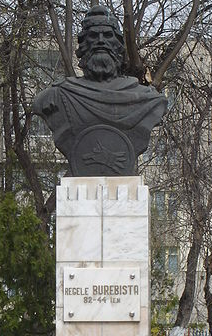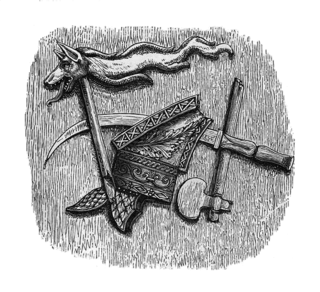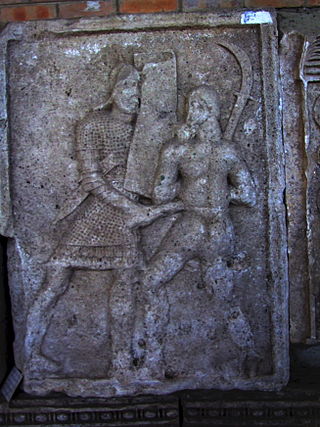Related Research Articles

The 80s was a decade that ran from January 1, AD 80, to December 31, AD 89.

Dacia was the land inhabited by the Dacians, its core in Transylvania, stretching to the Danube in the south, the Black Sea in the east, and the Tisza in the west. The Carpathian Mountains were located in the middle of Dacia. It thus roughly corresponds to present-day Romania, as well as parts of Moldova, Bulgaria, Serbia, Hungary, Slovakia, and Ukraine.

Moesia was an ancient region and later Roman province situated in the Balkans south of the Danube River. As a Roman domain Moesia was administered at first by the governor of Noricum as 'Civitates of Moesia and Triballia'. It included most of the territory of modern eastern Serbia, Kosovo, north-eastern Albania, northern parts of North Macedonia, Northern Bulgaria, Romanian Dobruja and small parts of Southern Ukraine.

Decebalus, sometimes referred to as Diurpaneus, was the last Dacian king. He is famous for fighting three wars, with varying success, against the Roman Empire under two emperors. After raiding south across the Danube, he defeated a Roman invasion in the reign of Domitian, securing a period of independence during which Decebalus consolidated his rule.

Burebista was the king of the Getae and Dacian tribes from 82/61 BC to 45/44 BC. He was the first king who successfully unified the tribes of the Dacian kingdom, which comprised the area located between the Danube, Tisza, and Dniester rivers, and modern day Romania and Moldova. In the 7th and 6th centuries BC it became home to the Thracian peoples, including the Getae and the Dacians. From the 4th century to the middle of the 2nd century BC the Dacian peoples were influenced by La Tène Celts who brought new technologies with them into Dacia. Sometime in the 2nd century BC, the Dacians expelled the Celts from their lands. Dacians often warred with neighbouring tribes, but the relative isolation of the Dacian peoples in the Carpathian Mountains allowed them to survive and even to thrive. By the 1st century BC the Dacians had become the dominant power.
Trajan's Dacian Wars were two military campaigns fought between the Roman Empire and Dacia during Emperor Trajan's rule. The conflicts were triggered by the constant Dacian threat on the Danubian province of Moesia and also by the increasing need for resources of the economy of the Empire.

The Third Battle of Tapae (101) was the decisive battle of the first of Trajan's Dacian Wars, in which the Roman Emperor defeated the Dacian King Decebalus's army. Other setbacks in the campaign delayed its completion until 102. The battle is most likely the battle-scene depicted on Plate 22 of Trajan's column.

Domitian's Dacian War was a conflict between the Roman Empire and the Dacian Kingdom, which had invaded the province of Moesia. The war occurred during the reign of the Roman emperor Domitian, in the years 86–88 AD.

The Battle of Adamclisi was a major clash during the Dacian Wars, fought in the winter of 101 to 102 between the Roman Empire and the Dacians near Adamclisi, in modern Romania.

Trajan's First Dacian War took place from 101 to 102.

Trajan's Second Dacian War was fought between 105 and 106 because the Dacian king, Decebalus, had broken his peace terms with the Roman Emperor Trajan from the Trajan's First Dacian War.
Cornelius Fuscus was a Roman general who fought campaigns under the Emperors of the Flavian dynasty. He first distinguished himself as one of Vespasian's most ardent supporters during the civil war of 69 AD, known as the Year of the Four Emperors. Vespasian's son Domitian employed Fuscus as prefect of the Praetorian Guard, a post he held from 81 until his death.

Tiberius Claudius Maximus was a cavalryman in the Imperial Roman army who served in the Roman legions and Auxilia under the emperors Domitian and Trajan in the period AD 85–117. He is noted for presenting Trajan with the head of Dacian king Decebalus, who had committed suicide after being surrounded by Roman cavalry at the end of Dacian Wars.

The military history of Romania deals with conflicts spreading over a period of about 2500 years across the territory of modern Romania, the Balkan Peninsula and Eastern Europe and the role of the Romanian military in conflicts and peacekeeping worldwide.

Duras, also known as Duras-Diurpaneus, was king of the Dacians between maybe AD 69 and 87, during the time that Domitian ruled the Roman Empire. Duras' immediate successor was Decebalus.

The history of Dacian warfare spans from c. 10th century BC up to the 2nd century AD in the region defined by Ancient Greek and Latin historians as Dacia, populated by a collection of Thracian, Ionian, and Dorian tribes. It concerns the armed conflicts of the Dacian tribes and their kingdoms in the Balkans. Apart from conflicts between Dacians and neighboring nations and tribes, numerous wars were recorded among Dacians too.

Dacii (The Dacians) is a 1967 historical drama film about the run up to Domitian's Dacian War, which was fought between the Roman Empire and the Dacians in AD 87-88. The film shows historical events about Romania.
This section of the timeline of Romanian history concerns events from Late Neolithic until Late Antiquity, which took place in or are directly related with the territory of modern Romania.
Lucius Tettius Julianus was a Roman general who held a number of imperial appointments during the Flavian dynasty. He was suffect consul for the nundinium of May–June 83 with Terentius Strabo Erucius Homullus as his colleague.
The history of Dacia comprises the events surrounding the historical region roughly corresponding to the present territory of Romania and Moldova and inhabited by the Getae and Dacian peoples, with its capital Sarmizegetusa Regia.
References
- ↑ Alexandru Vulpe, Storia e Civiltà della Dacia preromana, in Traiano ai confini dell'Impero, a cura di Grigore Arbore Popescu, Milano 1998, p. 108.
- ↑ Dio Cassius, Storia romana, LVII, 10, 3.
- ↑ Cambridge University Press, Storia del mondo antico, L'impero romano da Augusto agli Antonini, vol. VIII, Milano 1975, pp. 616-7.
- ↑ Suetonius. "The Twelve Caesars" . Retrieved 19 March 2012.